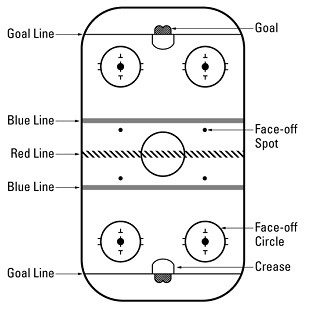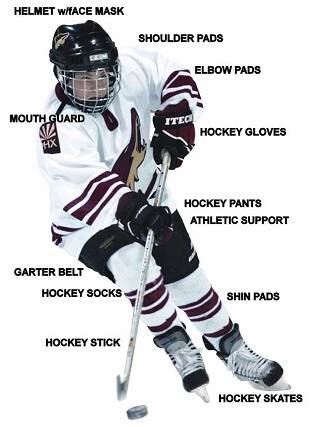RULES OF ICE HOCKEY UK: Allow six skaters in each team to drive and shoot a small rubber disc (puck) into the opposing goal.
Give each player a hooked stick and you are playing Ice Hockey.
Officiating ice hockey regulations is for the speediest of match officials only. That’s partly because the fastest team game in the world happens to be ice hockey.
The true birthplace of ice hockey is likely to have originated at Ontario in Eastern Canada. It is almost certain the game’s originators were Crimean war veterans around the 1860s.
Ice hockey in the UK devised its governance from the original rules and regulations. The modifications make for a unique game perfectly adapted for icy winter sports.
If you’re considering setting up your own ice hockey practice space, explore the options available and understand the synthetic ice rink cost for a convenient and efficient training experience. Investing in a synthetic ice rink can provide year-round access for honing your skills without worrying about weather conditions. Consider the long-term benefits of your training routine.
The main difference is the use of a square rubber puck instead of a ball, as used in field hockey rules.
The world governing body is the International Ice Hockey Federation. Founded in France in 1908, the IIHF governs the modern rules of ice hockey and inline hockey.
Great Britain (team GB) won their first honors as 1936 Olympic ice hockey champions. The English title used for the modern game in Britain is Ice Hockey UK.
Whatever your player role, be it netminder, defenceman, or forward. All six ice hockey players need to be skillful at stick handling and have superior skating speed. Apart from cunning tactics and agility, you also need oodles of grit to play the game.
Ice hockey is fast-paced physical sport played on a frozen playing surface. It is not a game for timid, faint hearted people to take part in – or to watch!
Ice Hockey Regulations
Object of Ice Hockey Game
The aim of the game ice hockey is to score more goals than your opponents do. You score by hitting and driving a small hard rubber puck with a hockey stick into their goal net.
Ice hockey players pass the vulcanized disc (puck) to each other by sliding it over the icy surface. Each team tries to intercept and prevent the opponents from scoring more goals than they do.
Ice Hockey Referees and Officials
As a general rule in ice hockey there are three referees and officials, depending on the league. There should be two linesmen and one referee (sometimes two). The role of ice hockey officials is officiating and controlling the game.
Ice Hockey Ice Rink
 An official National Hockey League ice rink measures 61 meters (200 feet) in length by 30 meters (85 feet) in width. International competition rinks are wider by an extra 4.5 meters (15 feet).
An official National Hockey League ice rink measures 61 meters (200 feet) in length by 30 meters (85 feet) in width. International competition rinks are wider by an extra 4.5 meters (15 feet).- The playing area between the goals divides into three zones.
- The defence, neutral, and attacking zones each measure close to one third of the pitch area.
- The ice hockey ice rink diagram shows the 3 main divisions of the playing surface:
- A single Red Line divides the ice rink in half.
- Two Blue Lines delineate the middle or neutral zone.
- There are 5 ‘Face-off Circles‘.
- There is one Goal, Net, and Crease at opposite ends of the rink.
- The middle zone is neutral and includes a centre circle where the game begins.
- Each team has one attacking zone and one defending zone (the other two thirds).
- Attack and defence zones have two end zone faceoff circles and face-off spots.
- The goal crease is a half circle surrounding the goal. The goals in ice hockey are 1.22m (4′) tall and 1.83m (6′) wide.
- There is usually an area for barrier boards located behind each goal net.
Ice Hockey Equipment
The ice hockey puck is a solid vulcanized dense rubber circular disc. It measures 7.62 cm (3″) in diameter and 2.54cm (1″) thick. Pucks are dense weighing 143 grams which is almost 6 ounces.
Ice Hockey Players Equipment List
Players have their own ice hockey stick and ice skates. They all wear specialized ice hockey equipment including:
- Designer knee pads and well-padded shin, elbow, hip, and shoulder guards. Thick gauntlet-type gloves and long stockings that fit over the knee pads.
- Padded shorts laced at the front and team-colored sweaters covering everything else.
- Ice hockey boots are different from figure skating boots and much stronger. They provide lower ankle support, reinforced toes, and padded tongues.
- The skate blade has a plain point which is straight and narrow with two upright and higher stanchions.
Starting a Game of Ice Hockey
In ice hockey rules UK, play starts with a face-off as the referee drops the puck inside the center circle. The puck gets dropped between the two ice hockey sticks of each team’s opposing center player.
Additional face-offs take place in face-off zones such as after a goal or to resume play after a stoppage for misplay. The puck is in play at all times unless a player hits it over the barrier fence or the whistle blows.
Ice Hockey Match Length</5>
England Ice Hockey League regulation playing time is 60 minutes. The match length takes place over 3 separate 20-minute periods. There are two 15 minutes intermissions between each period. Teams change ends at the beginning of each new 20-minute period.
The 10 basic rules and regulations of ice hockey state that the clock must stop when an official blows a whistle.
Ice Hockey Players
- Ice hockey rules UK state there can be no more than six team players on the ice during normal play. One player must be the goaltender.
- The ice hockey player lineup is one netminder, two defencemen, and three forwards.
- English Ice hockey rules and regulations allow the changing of players at any time during the game.
- A full team is usually made up of 17, but no more than 20 players. A squad consists of two netminders, four to six playing in the defence, and three to four lines of forwards.
- The netminder will usually remain unchanged throughout the game. But it is quite common for him to leave the ice during the last seconds of a game.
- This means there is no ice hockey goalie but six outskaters on the ice in a risk-all effort to score.
- This happens most often at the end of a game where a single goal separates the teams. It can be the most exciting and tense few minutes in the game.

General Match Regulations in Ice Hockey
- Players may use physical force or body checking to win the puck off their opponent. But an attack player may only enter the attacking zone behind the puck or puck-carrier.
- You cannot make a pass to an attacker from any team-mate who is outside the attacking zone. This is ice hockey offside rule and the whistle blows for a faceoff.
- Players get penalized with a sending off for infringements of the rules. You must leave the ice for two or more minutes, according to the severity of the offence. Sent off players must stay in a special penalty box for the duration of the penalty. The team cannot substitute a player during his penalty time.
- A sent off player can return to the rink immediately if the opposing team score a goal during the 2 minute penalty.
- The goaltender does not serve out his own penalties. Instead, a team-mate must sit in the box for most penalties given against him. The exception could be if the ice hockey goalie gets thrown out of the game altogether.
- A player may stop the puck with hand, body or skate at any time and from any playing position.
- Players can only push the puck forward using a skate or the hockey stick.
Scoring a Goal in Ice Hockey Explained
You score a goal by propelling the puck with a stick over the goal line, or when it goes straight into the net. Players can use any part of their body or their stick to do so, but cannot use their hand or foot to throw or kick it. The whole of the puck needs to cross the line for it to be a legal goal.
In professional leagues, like the NHL, the goal line has a sensor running across it. The sensor indicates when the puck has completely crossed the line. Amateur ice hockey leagues rely on the expert judgment of the umpires. Goal judges sit behind each net and signal when you score a goal by switching on a red light.
Ice Hockey Penalties
A penalty in ice hockey results with the player spending an allotted time in the penalty box. There are three types of ice hockey penalties. The penalty classifications are minor, major, and misconduct. Needless to say, the harsher the penalty – the harsher the punishment.
Major offences will result in a 5 minute removal from the ice. They get ruled for inflicting serious injury, fighting, or for making repeated minor violations. Common ice hockey fight rules govern:
- Butt Ending: Jabbing an opponent with the top end of your stick.
- Checking from Behind: Whistled when a player hits an opponent from behind and therefore cannot defend himself.
- Cross Checking: Player makes a check with both hands on the stick.
- Elbowing: When a player uses his elbow to foul an opponent.
- Fighting (ice hockey fisticuffs): When players drop their gloves and throw punches at each other.
- Hooking: When a player impedes the progress of an opponent by ‘hooking’ him with his stick.
- Interference: Interfering with or impeding an opponent who does not have the puck.
- Kneeing: Player fouling an opponent with his knee.
- Roughing: Striking another opponent in a minor altercation that the referee determines is not worthy of a major penalty.
- Slashing: Hitting an opponent with your stick, or ‘slashes’ at him to impede his progress or cause injury.
- Spearing: Stabbing at an opponent with the blade of your stick.
- Tripping: Using the stick (or body) to cause an opposing player to fall down.
Winning a Game of Ice Hockey UK
In UK ice hockey rules and regulations every goal earns one point for your team. The winners will be the ones with most goals at the end of the game. The game moves into extra time if there is a tie; the first team to score in overtime gets crowned as winners.
Advanced UK Ice Hockey Rules
ALSO IN THIS SECTION
A to Z of Sports Rules: A detailed list of popular indoor and outdoor sport categories.
Basic Rules of Ice Hockey: The essential start for all beginners and newcomers to the game.
Ice Hockey Equipment List: Find out what ice hockey equipment you need to play and compete.
Offside Rule Ice Hockey: A simple guide to help you understand offsides in ice hockey.
Ice Hockey Positions: Check out the 6 player positions and their tactical roles.
Field Hockey Rules: Basic regulations for playing the sticks outdoor field hockey game.
Weird Sports Rules: A concise list of weird and wonderful sports games around the world.
IIHF Rule Book PDF: [Free Download Option]

